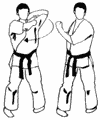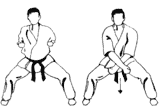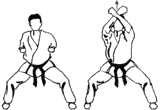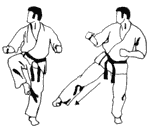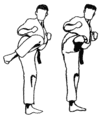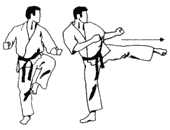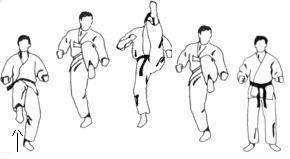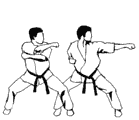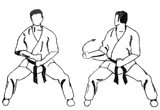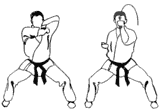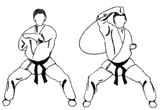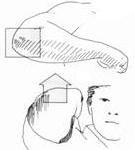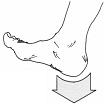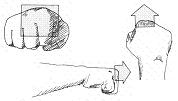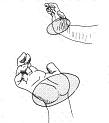|
Stance
Name
|
Kanji |
Means
in English
|
|
Fudo
Dachi
|
.gif)  |
Normal
Stance
|
|
Kake
Dachi
|
  |
Hooked
Stance
|
|
kiba-dachi
or naifanchi-dachi
(horse stance)
|
  |
Straddle
Stance - Feet roughly two shoulder-widths apart,
parallel, toes pointed forwards.
|
|
kokutsu-dachi
(back stance)
|
  |
Back Leaning stanceRear
knee bent, with foot facing to the outside. Forward leg
approximately two shoulder-widths in front of and
perpendicular to rear foot (i.e. facing forwards). 70% of
weight on rear leg, 30% on foward leg. (Fighting Stance)
|
|
Musubi
Dachi (ready
stance)
|
  |
Heels
together, with each foot pointing outwards 45º (forming
a right angle between the feet).
|
|
neko-ashi-dachi
(cat stance)
|
   |
Cat Stance Rear
knee bent, with foot flat on ground, and toes facing to
the outside. Resting lightly (10%) on the front leg,
approximately one shoulder-width from the rear leg. Toes
of front foot facing forwards, flat on ground with heel
of foot raised. Crouching slightly, with front leg in
centre of body, bent a little at the knee. Torso erect.
|
|
sanchin-dachi
(tension stance)
|
  |
Feet
shoulder-width apart, weight distributed evenly over both
legs. Kneeds tensed and pulled inwards. Forward foot
slightly ahead of rear foot. Toes pointed slightly
inward. Back straight and hips tensed, with pelvis pulled
forwards and upwards.
|
|
Tsuruashi
Dachi
|
   |
Crane
Stance
|
|
heisoku-dachi
(ready stance)
|
  |
Feet
together, legs straight and relaxed.
|
|
heiko-dachi
(natural stance)
|
  |
Feet
parallel, shoulder-width apart.
|
|
soto-hachiji-dachi
or just hachiji-dachi
(natural stance)
|
    |
Feet
shoulder-width apart, feet both pointing outwards at 45º.
|
|
uchi-hachiji-dachi
(natural stance)
|
    |
As
for soto-hachiji-dachi but feet pointing slightly
inwards.
|
|
zenkutsu-dachi
(front stance)
|
  |
Forward
leg bent at the knee with 60% of weight on front leg and
40% on rear leg. Knee of rear leg locked and extended
approximately two shoulder-widths behind lead foot. Torso
erect.
|
|
han-zenkutsu-dachi
(half front stance)
|
  |
As
for zenkutsu-dachi, but feet only one shoulder-width
apart.
|
|
gyaku-zenkutsu-dachi
(rear defense stance)
|
   |
As
in zenkutsu-dachi but turned around so straight leg
points forward. Head and torso turned to face
|
|
shiko-dachi
(straddle stance)
|
  |
Feet
spread approximately two shoulder-widths apart, toes
pointed outward at 45º. Weight distributed evenly over
both legs. Knees bent deeply and pulled back as far as
possible. Torso erect. Lower legs/shins approximately
vertical.
|
|
shirasagiashi-dachi
or sagiashi-dachi
(one-legged or crane stance)
|
 |
Leg
raised and tucked behind knee of supporting leg.
Supporting leg bent at knee and foot turned outward,
weight shifted back above supporting leg.
|
|
renoji-dachi
(V stance)
|
 |
Feet
one shoulder width apart, front leg in centre of body
pointing directly forwards. Rear leg pointing outwards 45º.
Legs relaxed and straight.
|
|
kosa-dachi
(crossed-leg stance)
|
  |
One
leg crossed over the other with both knees bent. Front
foot flat on ground. Rear leg supported on ball of foot.
Front foot facing to outside at 45º.
|
|
sesan-dachi
(side facing straddle stance)
|
 |
As
for shiko-dachi, but looking directly to the side.
|
|
fudo-dachi
or sochin-dachi
|
.gif)  |
(free/immovable
stance)
|
|
yoi-dachi |
  |
ready stance |
|
Migi Ashi Mae |
   |
right foot forward |
|
Hidari Ashi Mae |
   |
left foot forward |








